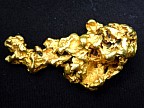AlluvialGold Nuggets
3 posters
Gold Detecting and Prospecting Forum :: General :: Prospecting Answers :: Gold, Gemstones & Their Properties
Page 1 of 1
 Re: AlluvialGold Nuggets
Re: AlluvialGold Nuggets
Jefgold wrote: These heavy Gold chunks fall away to be found later in the lower lying geographical areas.
nero_design
There is also another theory to Nero's.
The millions of years our earth has been developing the now low lying geographical areas may have been the upper. As the earth cooled and the pitching and heaving of the strata made hilltops valleys and vice versa.
So to sit and study recent land formations and theorise where gold has shed from is extremely difficult.
Peter
 Re: AlluvialGold Nuggets
Re: AlluvialGold Nuggets
That's true, Peter... and it accounts for why some nuggets are found in the most unusual places.
The majority of gold has gone through a great deal of change. From the depths of the earth, the gold has been deposited in fine layers in the host rock where venting has taken place. These layers have built up under pressure until substantial deposits are formed. After breaking away due to erosion of the host rock (eg. Quartz), the gold inevitably and eventually falls to low lying areas (benches and gullies). The technique of "loaming" for gold is where the Prospector samples soil at the bottom of a raised geographical terrain and works his way uphill to find the source of the shed alluvial material. I know of a number of places where the panner can scoop up soil on the top of a mountain or tall hill and pour the soil from shoulder height to another pan and hear the clink of small granules of gold. This smaller and lighter gold has a smaller volume and therefore the weight is less.... thus the interaction of gravity is not as great on smaller pieces. But it certainly is on larger nuggets. When it rains, these smaller bits regularly wash downhill into the creeks and rivers. The larger chunks are usually cajoled further down from the topsoil. Erosion may reveal such nuggets so that they end up glinting in the sunlight. More often though, they sink down in moist soils and shifting matrix until coming to rest on bedrock. The surrounding material may cement into a conglomerate (eg Western Australian Gold Specimens in mixed concretions) or the nuggets may get washed into a stream. These nuggets (if caught in a watercourse) may become rounded and smooth. Contrary to popular belief, such smooth nuggets become waterworn not because of being rolled, but by sand, gravel and other stones rolling over the "immovable" nugget, rounding the outer surface over time.
As you've mentioned, it certainly is extremely difficult to look at the surrounding terrain and imagine what it was once like although I have been doing this recently. It can be very disconcerting to pick up an odd looking stone on an inland mountain on the Goldfields here and find that it is fossilized coral.
See images below which I created to show the differences.

The now-eroded sulphuric acid volcanoes in the Turon region of NSW were able to deposit some of the Gold "salts" into the vents in the surrounding terrain. These vents were lined with quartz which later broke away to reveal the accumulated gold within. Much of it has ended up in creeks and the river system there but concentrations of reef Gold there resulted in nuggets as large as 130 ounces being extracted with a degree of regularity in 1835. These days, it remains for ever-deeper seeking detectors to find the heavier nuggets which are currently resting on bedrock and out of range of some current and most previous models. I know of several miners working professionally in the Hill End and Sofala regions who have reopened the mines there and have drilled out and exposed VAST quantities of solid gold masses that may even put the multi-kilo-nuggets of yesteryear to shame. This material is off limits to the detectorist but it's nice to know that such treasures are still there, just out of reach for us topside ground scanners.
The majority of gold has gone through a great deal of change. From the depths of the earth, the gold has been deposited in fine layers in the host rock where venting has taken place. These layers have built up under pressure until substantial deposits are formed. After breaking away due to erosion of the host rock (eg. Quartz), the gold inevitably and eventually falls to low lying areas (benches and gullies). The technique of "loaming" for gold is where the Prospector samples soil at the bottom of a raised geographical terrain and works his way uphill to find the source of the shed alluvial material. I know of a number of places where the panner can scoop up soil on the top of a mountain or tall hill and pour the soil from shoulder height to another pan and hear the clink of small granules of gold. This smaller and lighter gold has a smaller volume and therefore the weight is less.... thus the interaction of gravity is not as great on smaller pieces. But it certainly is on larger nuggets. When it rains, these smaller bits regularly wash downhill into the creeks and rivers. The larger chunks are usually cajoled further down from the topsoil. Erosion may reveal such nuggets so that they end up glinting in the sunlight. More often though, they sink down in moist soils and shifting matrix until coming to rest on bedrock. The surrounding material may cement into a conglomerate (eg Western Australian Gold Specimens in mixed concretions) or the nuggets may get washed into a stream. These nuggets (if caught in a watercourse) may become rounded and smooth. Contrary to popular belief, such smooth nuggets become waterworn not because of being rolled, but by sand, gravel and other stones rolling over the "immovable" nugget, rounding the outer surface over time.
As you've mentioned, it certainly is extremely difficult to look at the surrounding terrain and imagine what it was once like although I have been doing this recently. It can be very disconcerting to pick up an odd looking stone on an inland mountain on the Goldfields here and find that it is fossilized coral.
See images below which I created to show the differences.

The now-eroded sulphuric acid volcanoes in the Turon region of NSW were able to deposit some of the Gold "salts" into the vents in the surrounding terrain. These vents were lined with quartz which later broke away to reveal the accumulated gold within. Much of it has ended up in creeks and the river system there but concentrations of reef Gold there resulted in nuggets as large as 130 ounces being extracted with a degree of regularity in 1835. These days, it remains for ever-deeper seeking detectors to find the heavier nuggets which are currently resting on bedrock and out of range of some current and most previous models. I know of several miners working professionally in the Hill End and Sofala regions who have reopened the mines there and have drilled out and exposed VAST quantities of solid gold masses that may even put the multi-kilo-nuggets of yesteryear to shame. This material is off limits to the detectorist but it's nice to know that such treasures are still there, just out of reach for us topside ground scanners.

nero_design- Contributor Plus

- Number of posts : 2090
Registration date : 2008-11-18
 Re: AlluvialGold Nuggets
Re: AlluvialGold Nuggets
Love your work nero design 
I understand what you mean about marine fossils on mountain ranges.There are numerous amounts of fossils spread on hillsides in the upper Turon region.
To imagine that this area was indeed covered by an ocean just shows how many changes had taken place over many millennia.And that dosent include iceages and glacial movement either.
Most of our present day river systems (Hawkesbury,Shoalhaven and the Clarence)have endured countless floods and are still cutting their original coures many millions of years after the continents divided.
I understand what you mean about marine fossils on mountain ranges.There are numerous amounts of fossils spread on hillsides in the upper Turon region.
To imagine that this area was indeed covered by an ocean just shows how many changes had taken place over many millennia.And that dosent include iceages and glacial movement either.
Most of our present day river systems (Hawkesbury,Shoalhaven and the Clarence)have endured countless floods and are still cutting their original coures many millions of years after the continents divided.
Scratchin4nuggets- Contributor

- Number of posts : 52
Registration date : 2008-12-11
 Similar topics
Similar topics» How much is a Nugget Worth?
» Do all quartz seams run North to South?
» Dollys Creek worth detecting
» Nuggets From Down Under
» A new metal detecting store at Mudgee in NSW
» Do all quartz seams run North to South?
» Dollys Creek worth detecting
» Nuggets From Down Under
» A new metal detecting store at Mudgee in NSW
Gold Detecting and Prospecting Forum :: General :: Prospecting Answers :: Gold, Gemstones & Their Properties
Page 1 of 1
Permissions in this forum:
You cannot reply to topics in this forum